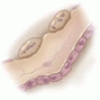Table of Contents
From the Editor
- When a quick sound bite won’t do
In the Action to Control Cardiovascular Risk in Diabetes (ACCORD) trial, why did more patients die if they got intensive therapy than if they got standard therapy? In this issue of the Journal, an investigator in this trial gives his analysis.
The Clinical Picture
- A judgment call
A young man hospitalized because of a sickle cell crisis requires a central venous line. However, after the catheter is inserted, an initial chest radiograph reveals that the tip may not be in the right place. What should be done?
Editorial
- Preventing renal disease progression: Can complete renin-angiotensin- aldosterone blockade work?
In view of the risks of complete blockade of the renin-angiotensin- aldosterone pathway, more data from clinical trials are needed before the general medical community widely applies this strategy to prevent progressive chronic kidney disease.
Review
- An update on proteinuric chronic kidney disease: The dual-goal approach
To slow the progression of proteinuric chronic kidney disease, we may need to set goals for lowering both blood pressure and urinary albumin excretion, using drugs that block the renin-angiotensin-aldosterone system at multiple sites or in higher doses. However, this dual-goal approach needs to be validated prospectively.
- Which patients benefit from carotid stenting? What recent trials show
Whether carotid stenting has any advantage over carotid surgery and which patients should undergo it are still topics of study and debate.
- Nonalcoholic fatty liver disease: A manifestation of the metabolic syndrome
As we get heavier, our livers get fattier. Despite an explosion of research on nonalcoholic fatty liver disease and gains in understanding its epidemiology and pathogenesis, a number of issues remain unresolved, including how to treat it.
Interpreting Key Trials
- A Clinician and Clinical Trialist’s Perspective
Even though more people died in the intensive-treatment group than in the standard-treatment group, the results from this trial should not substantially alter our usual approach to glucose-lowering.
Review
- Using biochemical markers of bone turnover in clinical practice
Although no guidelines to date recommend the widespread use of these markers in clinical practice, we believe they will eventually be accepted.
Editorial
- Biochemical markers of bone turnover: Useful but underused
Markers tell us the risk of fracture and are useful in patient management. But will insurance pay for testing?




